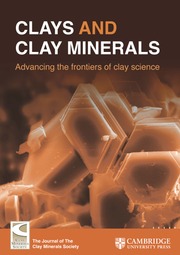Article contents
Pore Geometry as a Limiting Factor for Anion Diffusion in Argillaceous Rocks
Published online by Cambridge University Press: 01 January 2024
Abstract
Several barrier types are envisaged to minimize the release of radionuclides from waste matrices into groundwater. In a number of countries argillaceous rocks make up the natural barrier that will isolate radioactive substances from the aquifer. The present study addresses the influence of pore geometry as a limiting factor for anion diffusion in argillaceous rocks. Irrespective of the pore core size, anion diffusion can be limited by the pore-size opening, i.e. if the pore opening is so narrow that the electric double layers overlap and form a barrier to anions irrespective of the pore size. This so-called ‘bottleneck effect’ limits the anion diffusion. The present study extends previous investigations that focused on other factors which limit anion diffusion, e.g. mineralogy or interlayer equivalent pores. The existence of bottleneck pores was confirmed by effective tortuosity calculations and retention-potential measurements using mercury intrusion porosimetry. On the basis of two different core samples from argillaceous rocks from Switzerland, Opalinus Clay and Helvetic Marl, this work shows evidence of the existence of bottleneck pores. The larger permanent anion exclusion in the Helvetic Marl sample compared to the Opalinus Clay sample can be explained by the larger retention potential and larger effective tortuosity of the Helvetic Marl rock, which indicates more pores with bottleneck effects than is the case for the Opalinus Clay rock.
Information
- Type
- Article
- Information
- Copyright
- Copyright © Clay Minerals Society 2018
References
- 5
- Cited by

